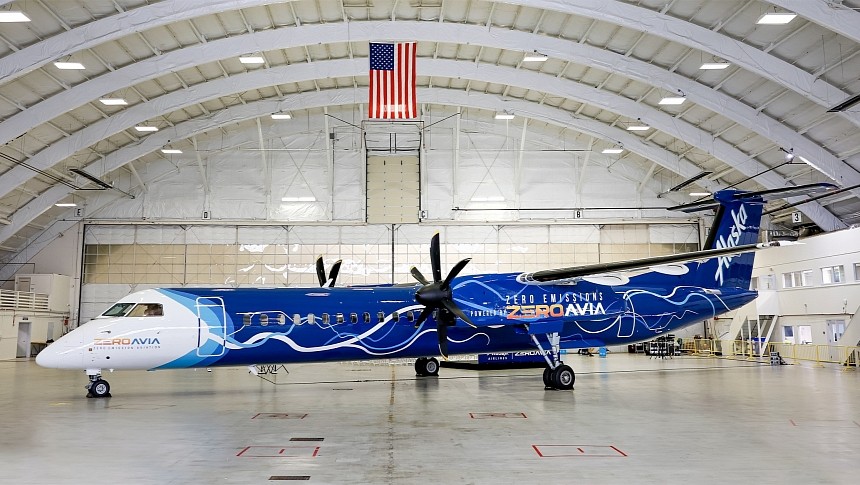An old, retired aircraft fitted with a revolutionary hydrogen-electric propulsion system is the perfect symbol of a dawning era in commercial aviation. One of the most sustainable yet innovative solutions for green flights comes from ZeroAvia, gearing up to take flight literally with Alaska Airlines.
Alaska Airlines and its subsidiary Horizon Airlines have retired their Dash 8-400 fleet. Yet, a single one of these aircraft stayed in place, about to become a research platform for zero-emissions technology. This De Havilland Canada Dash 8-400 (also known as the Q400, originally manufactured by Bombardier) is gearing up to become the largest zero-emission aircraft in the world.
The one who will make this possible is ZeroAvia, a company headquartered in both the US and the UK, which is developing hydrogen-electric solutions for aviation from scratch. Following other impressive milestones related to its ZA hydrogen powertrains, ZeroAvia will now retrofit this 76-seat turboprop – its most challenging endeavor so far. As mentioned above, the old aircraft with a new heart won't return to commercial service but operate as a research and development tool.
Three years ago, the company demonstrated its 250 kW system in flight. It was a huge milestone, as the world's largest aircraft to fly with a new-generation, zero-emission power source. Earlier this year, the 600 kW engine (the ZA600) powered a 19-seat aircraft during another trailblazing flight. The next goal is to certify the ZA2000, capable of powering 40-80 seat regional aircraft with a 700 miles (1,126 km) range.
Alaska Airlines first invested in ZeroAvia in 2021 and formally handed the Q400 during a ceremony at Paine Field in Snohomish County, Washington, where ZeroAvia owns a research and development site.
What made the event even more exciting was a live demonstration of the company's modular electric motor system using a 15-ton HyperTruck. The engine was a 1.8 MW prototype. In addition to the engine, ZeroAvia is also developing high-temperature PEM fuel cells, liquid hydrogen storage solutions, and dedicated electronics.
It claims that HyperCore is the most advanced electric motor for aircraft right now, worldwide. The 900 kW HyperCore, operating at 20,000 rpm, is said to match conventional turbine engine speeds, also boasting a 15 kW/kg power density.
Before the demonstration at Paine Field, ZeroAvia has been intensively testing the 1.8 MW prototype at its main location in Hollister, California. The configuration includes two HyperCore motor modules, which were tested with the stock Dash 8-400 gearbox and propeller.
Several airlines have already ordered ZeroAvia's retrofit solution for green commercial flights. This new project with Alaska Airlines is intended to speed things up for the ZA2000, set to become operational by 2027. Before that, the ZA600 will enable green regional flights as soon as 2025.
The one who will make this possible is ZeroAvia, a company headquartered in both the US and the UK, which is developing hydrogen-electric solutions for aviation from scratch. Following other impressive milestones related to its ZA hydrogen powertrains, ZeroAvia will now retrofit this 76-seat turboprop – its most challenging endeavor so far. As mentioned above, the old aircraft with a new heart won't return to commercial service but operate as a research and development tool.
Three years ago, the company demonstrated its 250 kW system in flight. It was a huge milestone, as the world's largest aircraft to fly with a new-generation, zero-emission power source. Earlier this year, the 600 kW engine (the ZA600) powered a 19-seat aircraft during another trailblazing flight. The next goal is to certify the ZA2000, capable of powering 40-80 seat regional aircraft with a 700 miles (1,126 km) range.
Alaska Airlines first invested in ZeroAvia in 2021 and formally handed the Q400 during a ceremony at Paine Field in Snohomish County, Washington, where ZeroAvia owns a research and development site.
What made the event even more exciting was a live demonstration of the company's modular electric motor system using a 15-ton HyperTruck. The engine was a 1.8 MW prototype. In addition to the engine, ZeroAvia is also developing high-temperature PEM fuel cells, liquid hydrogen storage solutions, and dedicated electronics.
It claims that HyperCore is the most advanced electric motor for aircraft right now, worldwide. The 900 kW HyperCore, operating at 20,000 rpm, is said to match conventional turbine engine speeds, also boasting a 15 kW/kg power density.
Before the demonstration at Paine Field, ZeroAvia has been intensively testing the 1.8 MW prototype at its main location in Hollister, California. The configuration includes two HyperCore motor modules, which were tested with the stock Dash 8-400 gearbox and propeller.
Several airlines have already ordered ZeroAvia's retrofit solution for green commercial flights. This new project with Alaska Airlines is intended to speed things up for the ZA2000, set to become operational by 2027. Before that, the ZA600 will enable green regional flights as soon as 2025.








